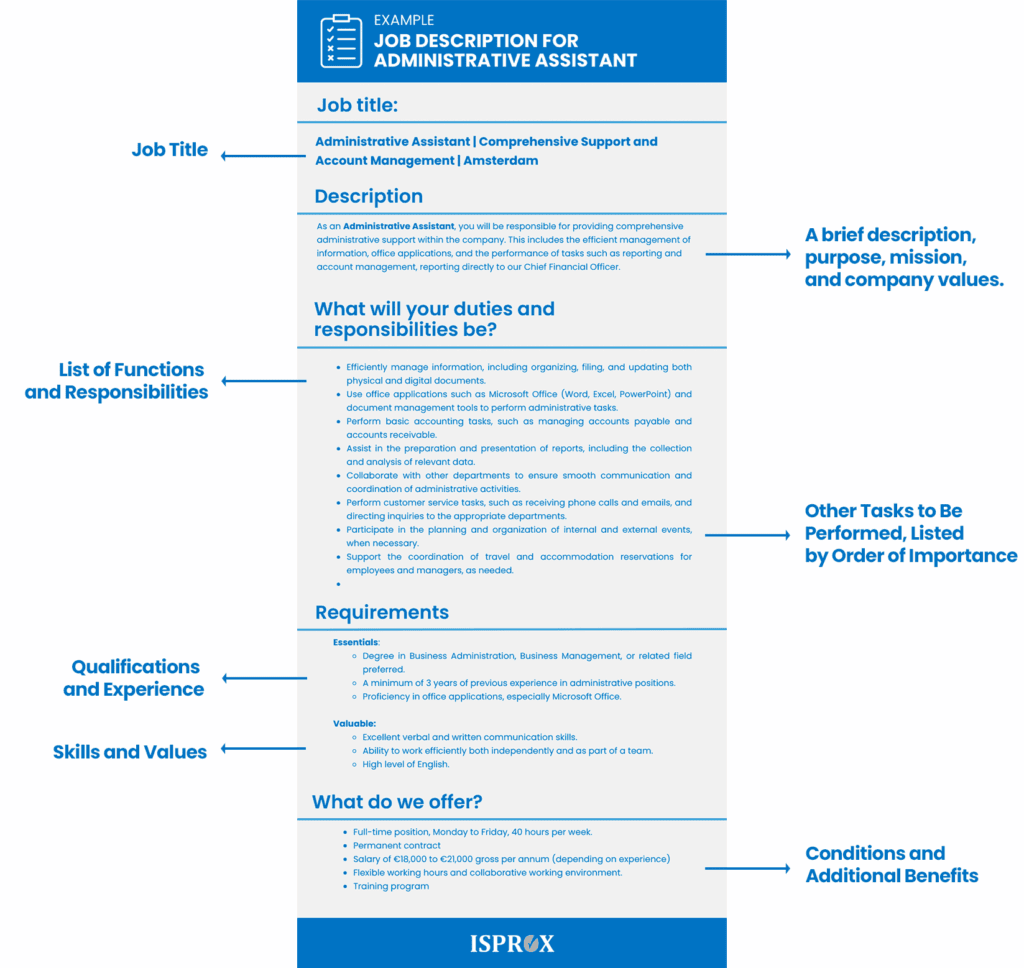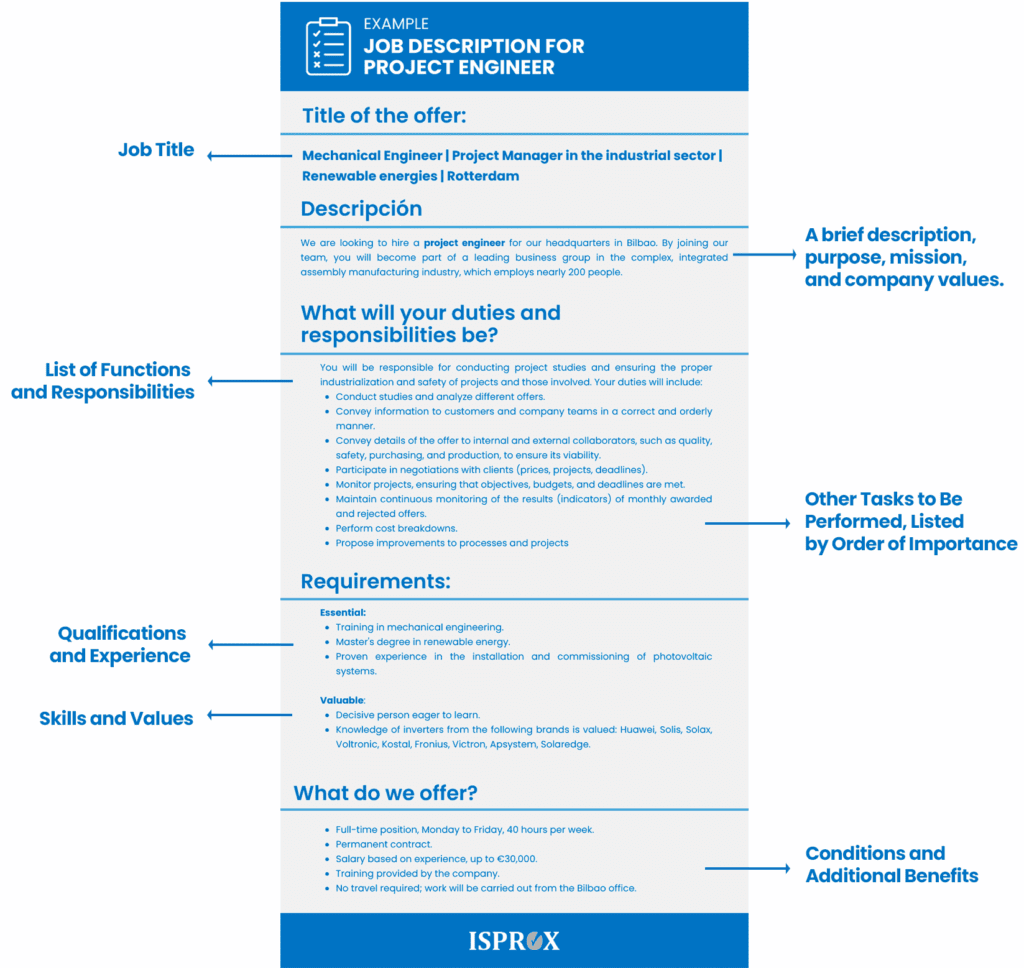A job description must be written before the recruitment process begins. It can be decisive in attracting the right talent and optimizing the time spent managing the process.
If you are wondering how to write an effective job description to choose the ideal candidate, the key is using a template to write an effective job description that contains all the necessary information.
Importance of a good Job Description
Job descriptions should be clear and detailed enough so that anyone reading them can easily find the information they need.
This is extremely important because it helps your human resources department filter applications and streamline talent recruitment efforts.
The job description form, in this regard, is a very useful business tool for developing the duties and responsibilities that will be assumed by the candidate who ultimately fills the position you are looking to fill.
From a candidate’s perspective, a company’s job description should include the position’s objectives, required activities, responsibilities, benefits, and other relevant information. Doing so will make it more likely that ideal candidates will be interested.
What are the advantages of writing a good job description?
Properly written job descriptions enable you to identify the strengths and weaknesses of applicants. They will also indirectly reveal those that are generally present in your company’s organizational structure.
With this information, it will be easier for you to correct errors and, consequently, optimize the selection processes.
From job description to profession profile
If you create a job profile for each position based on the description of your jobs, you will have a comprehensive and effective system for objectively filtering candidates who show interest in joining your organization during the resume screening and interview process. The creation of the job profile will also highlight the possibilities for staff relocation based on the requirements of the positions within your organization and the skills of your employees.
This leads to better use of talent, enabling the creation of performance-based incentive schemes that allow you to establish incentives for increased productivity. In this way, you will achieve a healthy competitive environment among your workforce.
The job profile is also a very useful tool for determining situations and degrees of disability that an employee may present, which helps to clarify and streamline the legal processes related to each specific case.
Bad practices to avoid when describing job positions
When considering how to write a job description, it is extremely important to pay special attention to a series of bad practices that can have negative effects if you engage in them. Writing unrealistic job offers, for example, will mean that all your efforts will have been in vain.
It is also not advisable to use internal or overly technical terminology in the job description. This can confuse applicants and discourage them from applying for the position you have advertised.
Of course, you should avoid using superlatives, as well as any terms that could be considered discriminatory. When communicating your company’s values, diversity and inclusion play an important role. That’s why making these mistakes could seriously damage your business’s reputation.
An attractive job description can lead to a significant reduction in recruitment costs, as well as an improvement in Recruitment Process. It can also increase the conversion rate from candidate to employee.
Step by step: how to write a job description
To be effective, a company’s job descriptions must strike the perfect balance between providing the necessary information to attract candidates and tailoring it to fit the desired profile.
Here are some recommendations to keep in mind when writing an effective job description, along with the step-by-step process you should follow.
1. Conduct a preliminary study of the requirements of the position to be filled
Conducting an analysis and reflection before writing the job description is key to identifying potential deficiencies in that area and how to address them.
You should not focus on the skills of the person who previously held the position, nor on the duties they had been performing.
Rather, it is advisable to identify the competencies that the candidate who will take over should have. In other words, what they will need to contribute in order to bring about an improvement that will also affect the entire organization.
2. Highlight the basic details of the position and the company offering it
Once the requirements of the position and the characteristics that the ideal candidate should have have been identified, the next step is to take action and put it on paper.
Job descriptions need to bring together the basic details of the vacancy and the organization offering it, and make sure they stand out.
In this sense, the description should start with the name of the job, the area within the company, and who the person reports to, all in a font that stands out visually.
3. Define and describe the duties of the position concisely
Clarity and conciseness are virtues that should be emphasized in job descriptions. It is important to draw up a precise list of the activities and tasks that the candidate will have to perform once they take up the position.
These roles must be clearly defined so that, after reading them, the person understands exactly what their day-to-day work in the organization would be like.
4. Bring together and list the essential requirements
When drawing up the list of essential requirements that applicants for the position must meet, precision is appreciated. The job description in this section should not be open to misinterpretation.
This will activate a filter that will help your recruiters save time and resources while directly identifying the talent your company needs, thereby reducing the margin of error.
Aspects such as academic training, personal skills, and professional experience come into play here. Clearly indicating whether these requirements are exclusive is essential. This will increase the likelihood that the applications you receive will match the requested profile.
5. Include and highlight desirable factors
Being too demanding with your list of requirements can cause setbacks. That’s why it’s important to carefully analyze which requirements are essential and which ones you can be flexible about.
In this regard, it is advisable to include a section that specifies desirable factors or skills. These are competencies that, while not essential for the position, can differentiate candidates and ultimately tip the balance.
6. Detail the salary range and value propositions for the employee
One of the main incentives that attracts talent to organizations is financial. For this reason, it is highly recommended to include the salary range for the vacancy in the job description. You will have to calculate this based on the value of the applicant.
It is also important to clearly state the benefits to which employees will be entitled, such as health insurance, a company car, and meal vouchers.
Key elements in job descriptions
To carry out an accurate and appealing job analysis and description, it is advisable to design a template for job descriptions or use an existing one.
ISPROX provides a downloadable template at the end of this article. However, if you would like to customize it, remember to include the following sections:
Job title and location
The job title should clearly specify the position and location, and it should also be attractive to applicants. How can you achieve this? See the tips and examples below for creating creative job titles.
- Relate the position to an essential soft skill: For example, if your company is looking for a creative data analyst in Madrid, instead of simply titling the position “Data Analyst | Amsterdam,” the title could be “Creative Data Analyst | Transform Numbers into Impactful Stories | Amsterdam.”
- Relate the position to a value or characteristic of your company: For example, if you are looking for a remote software engineer and innovation is part of your company’s DNA, a catchy job description title could be: “Innovative Software Engineer: Join our Leading Technology Team: Remote.”
If you prefer not to use a creative job title because it doesn’t align with your company’s communication tone, it doesn’t hurt to apply one of the following suggestions:
- Relate the Position to a Benefit from the Offer: For example, if you are looking for a sales representative for a bank and you offer continuous training and flexible hours, the job title in the job description could be:“Bank Sales Representative | Flexible Hours | Barcelona” or “Bank Sales Representative | Continuous Training | Barcelona”
- Highlight the professional category and the department or area the position belongs to. For example:
“Chief Operating Officer (COO) | Production Department | Valencia.”
Objectives and goals of the position
The job description must clearly define the objectives to be achieved and the expected results. It is also advisable to specify the required level of education and training, the risks associated with the position, and the tools, machinery, and equipment that must be used for the job.
Responsibilities and daily tasks
In this section, clearly and concisely specify the duties associated with the position. Include the activities and tasks the employee will perform daily and the level of responsibility the position entails. Other information, such as the company’s area of performance or professional sector and the position’s working hours and shifts, should also be included here.
Performance evaluation criteria
It is very important that the job description includes the method you will use to evaluate employee performance, as well as the incentives they will be eligible for if they meet the company’s objectives and proposed goals.
Examples of job descriptions
In summary, a well-developed job description includes an impactful summary, a strategic title that attracts applicants’ attention, and enough details for candidates to understand the position and company characteristics.
This will help you stand out from the competition, which is important when you consider that hundreds of job offers are posted on dozens of websites every day. Therefore, it’s crucial that the information you include is clear and unambiguous.
Good examples of job descriptions come from renowned international companies like Amazon, Netflix, and Glovo.
They stand out for having their own job portals and for their commitment to employer branding. Theorists define this term as “a long-term strategy to be recognized as a benchmark employer.” This is reflected on Iberdrola’s recruitment portal, for example.
Let’s look at some examples of good descriptions for specific positions:
Job description for administrative assistant
For reference, the description of an administrative position should specify whether a degree in business studies is required, if experience with information processing and office applications is necessary, and if the position involves responsibilities such as reporting or account management.

Job description for project engineer
A project engineer job description should specify the required degree and engineering license, whether previous experience in the sector or knowledge of specific regulations is necessary, the responsibilities involved, such as dealing directly with clients or supervising, and the design and visualization software in which the candidate must be proficient.

As talent recruitment consultants specializing in technical profiles, middle management, and executive recruitment for companies of all types and sectors, we manage your recruitment processes and accompany and advise you every step of the way. This includes defining and drafting the job description and selecting the final candidate.
Are you looking for talent to expand your team?
At ISPROX we help you find the right profile, saving you time and increasing your hiring success rate.










